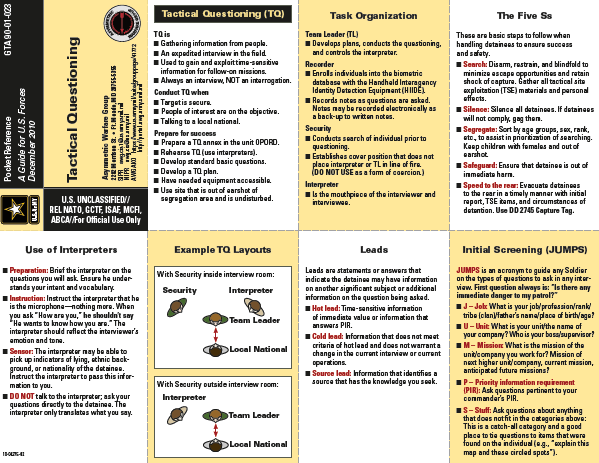Asymmetric Warfare Group
- 2 pages
- For Official Use Only
- December 2010
Tactical Questioning (TQ)
TQ is
■Gathering information from people.
■An expedited interview in the field.
■Used to gain and exploit time-sensitive information for follow-on missions.
■Always an interview, NOT an interrogation.Conduct TQ when
■Target is secure.
■People of interest are on the objective.
■Talking to a local national.Prepare for success
■Prepare a TQ annex in the unit OPORD.
■Rehearse TQ (use interpreters).
■Develop standard basic questions.
■Develop a TQ plan.
■Have needed equipment accessible.
■Use site that is out of earshot of segregation area and is undisturbed.…
Leads are statements or answers that indicate the detainee may have information on another significant subject or additional information on the question being asked.
■Hot lead: Time-sensitive information of immediate value or information that answers PIR.
■Cold lead: Information that does not meet criteria of hot lead and does not warrant a change in the current interview or current operations.
■Source lead: Information that identifies a source that has the knowledge you seek.Initial Screening (JUMPS)
JUMPS is an acronym to guide any Soldier on the types of questions to ask in any interview. First question always is: “Is there any immediate danger to my patrol?”
■J – Job: What is your job/profession/rank/tribe (clan)/father’s name/place of birth/age?
■U – Unit: What is your unit/the name of your company? Who is your boss/supervisor?
■M – Mission: What is the mission of the unit/company you work for? Mission of next higher unit/company, current mission, anticipated future missions?
■P – Priority information requirement (PIR): Ask questions pertinent to your commander’s PIR.
■S – Stuff: Ask questions about anything that does not fit in the categories above: This is a catch-all category and a good place to tie questions to items that were found on the individual (e.g., “explain this map and these circled spots”).…
Types of Questions
Direct: (Only authorized technique)
■An efficient method of asking precise questions toward a specific objective. Normally, who, what, when, where, why, and how begin the question.
■DON’T FORGET “ELSE”! (Who else, why else, where else, etc.)Tips
■ “War game” your techniques in rehearsals.
■ Do not depend on lists or cheat sheets (you may lose eye contact and miss an indicator of deception).
■ Have a focused approach (erratic questions all over the map will confuse both you and the detainee).
■ Be specific and focused with questions (if you want to know what the person’s profession is, ask “What is your profession?” not “What do you do?”).
■ Ask questions that cannot be answered with yes or no.
■ If you are doing most of the talking, he is winning!Do Not Use:
Vague:
■Questions that are not specific. These may lead to answers that are misinterpreted by the interviewer or elicit broad answers that are of no use.
Compound:
■Multiple questions contained within a single question: “When did you stage and conduct the attack?”
Negative:
■Phrasing that prompts the interviewee to make a negative response, whether true or not: “You didn’t see any CF while on your recon, did you?”
Leading:
■Questions that prompt the interviewee to give the answer he believes you want.

